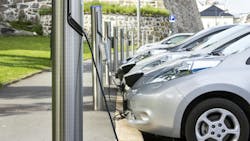Opinion
The slower-than-expected EV adoption rate of electric vehicles (EVs) is creating uncertainty in EV and EV battery development and production in the US. It is time for the Biden administration to reconsider its approach.
President Biden’s plan, which aims for 50% of all new vehicle sales to be electric by 2030, is a positive step towards transforming the United States into a green economy. However, the execution of this plan is causing friction for U.S. automakers trying to produce profitable EVs at affordable prices and for American consumers wanting to purchase them.
While the $7,500 EV tax-credit scheme has kickstarted the EV market, with 3 million EVs on the road in the US as of April 2023, adoption is slower than anticipated. As of Q2 2024, over 330,000 EVs were sold, accounting for 8% of new car sales. Tesla continues to dominate with a market share of 49.7%, while Ford and General Motors’ EV sales account for only 7.2% and 6.6%, respectively.
To meet Biden’s 50% goal by 2030, there is a need to accelerate both the supply and demand of EVs. This requires overcoming several challenges that are currently hindering progress.
EV Demand Challenges: High EV Prices and High Anxiety
One of the primary barriers to EV adoption is the high cost of electric vehicles. Despite lower energy costs, the average transaction price of a new EV was $53,376 in August 2023. This price remains prohibitively expensive for many American consumers, especially when financing an EV often comes with higher interest rates and higher insurance than traditional vehicles due to perceived risks associated with more expensive specialized parts and batteries.
In addition to costs, there is ongoing concern over the availability and accessibility of EV charging stations. As of February 2024, there were over 61,000 publicly accessible charging stations in the U.S., with most located in California, New York City and the Washington D.C. area. However, expanding the public EV charging network has faced delays and logistical challenges due to individual state regulators and bureaucracies. The sparsity of charging stations creates “range anxiety” among potential EV buyers, further slowing adoption.
To complicate matters, the integration of Tesla’s Supercharging network with other automakers such as Ford and GM has faced setbacks. Initially, Ford and GM were expected to gain access to Tesla’s Supercharger network by early 2024. However, this access has been delayed due to software issues and hardware shortages, further discouraging potential buyers from purchasing non-Tesla EVs.
EV Supply Challenges: Uncertain EV and EV Battery Development and Production
The slower-than-expected adoption of electric vehicles (EVs) is creating nervousness in EV and EV battery development and production in the US.
Ford has faced significant challenges in its EV strategy. In August 2024, Ford announced delays in the production of a next-generation all-electric pickup truck and the cancellation of plans for a three-row electric SUV. Prior to that, Ford delayed the opening of a new EV battery plant in Tennessee and scaled back its investment in another battery plant in Kentucky.
GM has its own challenges, including the temporary suspension of sales of its Blazer EV in December 2023 due to software glitches. In August 2024, GM delayed the start of production at a planned EV battery plant in Indiana by about a year, until 2027. To make matters worse, GM ended production of its Chevy Bolt EV at the end of 2023, which accounted for 62,045 or over 81% of its EV sales last year.
When U.S. automakers continually change their development and production plans for EVs and EV batteries, consumers lose confidence in the product quality and after-sales service of their EVs.
To stimulate EV supply and demand simultaneously, the U.S. government and automakers should adjust their current plans.
Easing Requirements for EV Tax Subsidies
To incentivize EV purchases, a $7,500 tax credit is available. However, the Inflation Reduction Act (IRA) introduced stringent requirements for these subsidies, creating challenges for U.S/ manufacturers.
To qualify for the full $7,500 tax credit, EVs must meet specific criteria regarding the sourcing of battery materials: at least 40% of the value of critical minerals used in the battery must be extracted or processed in the U.S. or a country with a free-trade agreement with the U.S.
In addition to material sourcing requirements, the IRA also imposes labor content requirements for EV tax subsidies. Vehicles must be assembled in the U.S. with a significant portion of their components manufactured domestically.
While these requirements aim to reduce dependence on foreign supply chains, particularly from China, they have also made it difficult for manufacturers to source sufficient materials such as lithium and cobalt domestically. At the same time, the North American labor content requirements (workers must make at least $16 per hour) make it difficult for U.S. automakers to leverage the USMCA to assemble lower-cost EVs in Mexico to reduce labor costs.
Currently, few models of affordable EVs are eligible for the tax credit. Nissan’s Leaf, with a base price of about $29,000, is the only affordable EV qualified for a $3,500 credit for its 2024 model sold after March 6, 2024. Unfortunately, other affordable brands such as Kia and Hyundai do not qualify for the $7,500 tax credit because they do not meet the government’s manufacturing requirements.
To give U.S. car manufacturers a chance to survive, it is understandable for Biden to impose a 100% tariff on Chinese EVs. However, to stimulate demand for affordable EVs assembled in the U.S. or Mexico, easing the IRA requirements on EV batteries would be a step in the right direction. This would require Congressional approval.
Reducing Financing Cost and Insurance Premiums
To further incentivize EV purchases, it is essential to reduce financing costs and insurance premiums. One plausible approach is for the government to offer lower-interest loans to qualified buyers, similar to student loans.
Additionally, automakers should consider following Tesla’s lead by offering insurance for their own EVs with lower premiums than traditional insurance firms. Tesla can offer lower premiums to good drivers because it uses real-time driving data to evaluate and track a driver’s behavior each month, determining the next month’s premium based on this data. This strategy can be a win-win: drivers pay lower premiums for good driving behavior, and firms face fewer accident insurance claims.
Developing Long-Term EV Commitments
Stimulating EV demand is key to transforming the United States into a “green economy.” U.S. automakers must demonstrate their long-term commitment to developing EVs, like Toyota’s long-term commitment to developing the Prius, which took years to become profitable. Strong commitments can boost consumer confidence in purchasing EVs.
The development of the EV market in the US is fraught with challenges. Overcoming these obstacles will require sustained investment, policy support, and collaboration across the industry. While blocking Chinese EVs from the US market can buy some time, the US government and automakers must take immediate action.
About the Author

Christopher S. Tang
Distinguished Professor and Ca
Christopher Tang is a distinguished professor and the holder of the Carter Chair in Business Administration at the UCLA Anderson School of Management.
A scholar of global supply chain management, Tang’s interest in his field began in the private sector when he worked for IBM to solve internal production planning problems. Exposure to real-life industry projects motivated his academic research, where he developed teaching cases on microfinancing for the poor, mobile platforms for developing economies and new business models in the age of the Internet, among other topics.
Tang has been a consultant to numerous corporations, including Amazon, HP, IBM, Nestlé and Accenture. He has published six books and in addition to being a regular contributor to IndustryWeek, he has written for the Wall Street Journal, Barron’s, Financial Times, China Daily, Fortune, Bloomberg Law and The Guardian.
